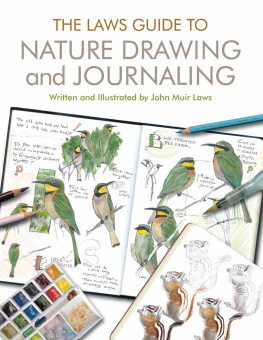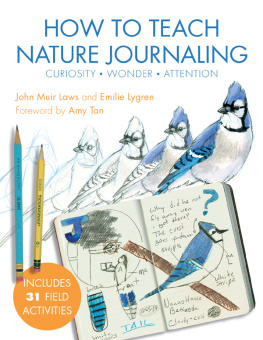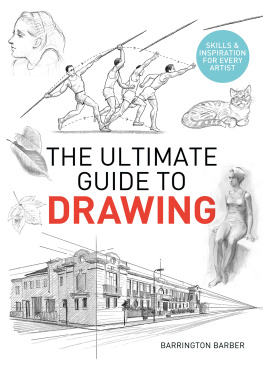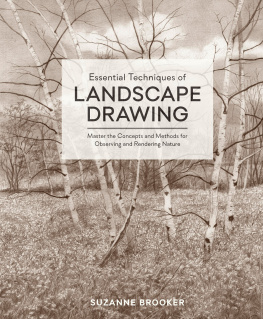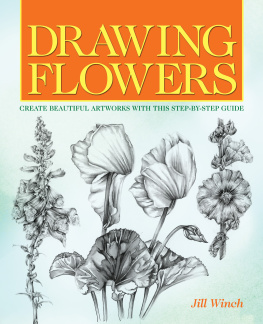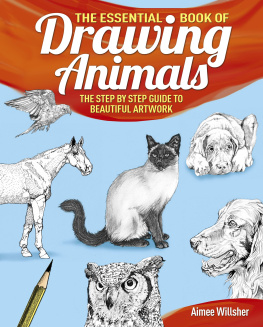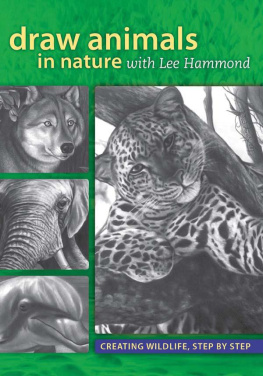Contents
Guide
THE LAWS GUIDE TO
NATURE DRAWING AND JOURNALING
THE LAWS GUIDE TO
NATURE DRAWING AND JOURNALING
Written and Illustrated by John Muir Laws
in joyful, inspired collaboration with Emilie Lygren
Heyday, Berkeley, California
This book was made possible by the generous support of the S. D. Bechtel, Jr. Foundation.
2016 by John Muir Laws
All rights reserved. No portion of this work may be reproduced or transmitted in any form or by any means, electronic or mechanical, including photocopying and recording, or by any information storage or retrieval system, without permission in writing from Heyday.
Library of Congress Cataloging-in-Publication Data is available
Cover Art: John Muir Laws
Cover Design: Leigh McLellan Design
Interior Design/Typesetting: John Muir Laws with Leigh McLellan Design
Orders, inquiries, and correspondence should be addressed to:
Heyday
P.O. Box 9145, Berkeley, CA 94709
(510) 549-3564, Fax (510) 549-1889
www.heydaybooks.com
10 9 8 7 6 5 4
CONTENTS
Collections and Field Guides Finding Patterns, Exceptions, and Changes over Time Recording Events Maps, Cross Sections, and Block Diagrams
Writing Diagramming Depicting Birdsong Lists Counting and Measuring Data Tools Your Curiosity Kit
Taking Notes Structuring Your Thoughts Plans, Projections, and Sections Organizing a Page: Titles, Icons, Frames, Callouts, and Arrows
Field Kits Essential Tools The Right Journal Your Palette
You Can Do It Flow Structure and Shape Blocking In Linework Value Color Details and Texture How to Show Depth Composition Shortcuts and Hacks
Graphite The Non-Photo Blue Pencil Water Soluble Pens Markers Ball-Point Pens Toned Paper Colored Pencils Iris Step by Step Watercolor Pencils Watercolors Gouache Heron Step by Step Rock Pigments
Insect Anatomy Ladybug Step by Step Insect Textures Butterfly Step by StepTransparent Wings Step by Step Spiders Amphibians and Reptiles Ensatina Step by StepLeopard Frog Step by Step Scales Birds Lazuli Bunting Step by Step Song Sparrow Birds in Flight Duck Profile Step by Step Assembling a Mallard Sketching Waders Red-Tailed Hawk Step by Step Mammals Muscles and Fur Mule Deer, Bear, and Mountain Lion Step by Step Tracking
Flower Symmetry Foreshortening Coned-Shaped Flowers Step by Step Leaves and Petals Plant Textures Mushrooms Step by Step
Contour Lines Shadows, Branches, and Bark Texture Conifers Douglas Fir Step by StepOak Tree Step by Step Rethinking Trees
Landscapitos Rocks Rock Outcrop Step by Step Sketching Mountains Mountain Landscapes Step by Step Grasses Oak Woodland Step by StepConiferous Forest Edge Step by Step Waterfalls Drawing Water and Waves Clouds Sunsets Mountain Sunset Step by Step
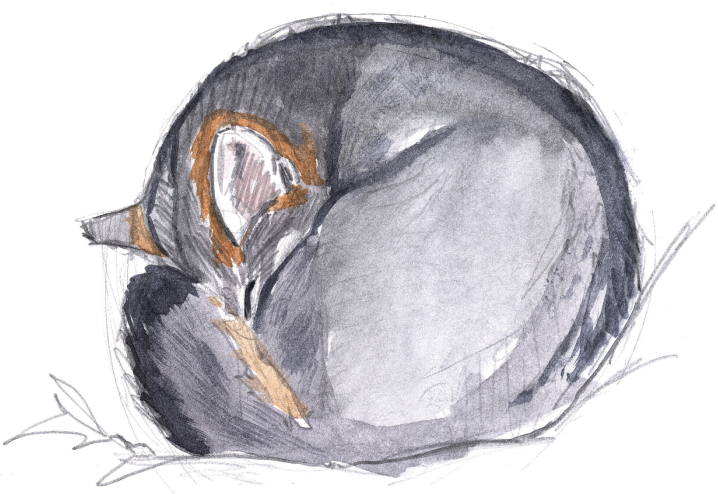
ACKNOWLEDGMENTS
I am deeply grateful to the mentors, teachers, patrons, and companions who supported, inspired, and trained me to do what I love.

I owe this book to the rich web of teachers, supportive friends, mentors, parents and partners who have inspired and directed me over the years. There is no way to know whose shoulders supported me the most or without whom I would not have written this book. I do know that I am grateful, humbled, and motivated to give the best of myself because of what all of you have given to me.
Both of my parents are amateur naturalists. Curious play in nature was a part of the fabric of our family outings. We spent countless days watching wildflowers and birds, and we spent summers in the Sierra Nevada and at the Point Reyes National Seashore. I watched my father make careful lists of wildflowers blooming at Chimney Rock to compare one year against another, learning phenology before we knew there was a word for it. My brother, James, was my partner and co-conspirator in these childhood adventures and to this day inspires my art, curiosity, and backcountry wanderings.
My wife, Cybele Renault, and I now raise our own family. We hope to instill the same love of nature in our children, Amelia and Carolyn. I am deeply grateful to Cybele for her love, support, humor, and patience. She understands why this work is so important to me and helps me to do the best that I am able.
I am dyslexic. You might be interested to see early drafts of this manuscript, the writing filled with phonetic misspellings. In my childhood, I thought that not being able to spell meant I was stupid. I was struggling in school, but in nature I felt alive and safe from the red pens. I was fascinated by natural history and kept a logbook of my encounters and discoveries. I felt safe sketching, so most of my notes were drawings. Anything you practice gets better, and I filled journals with practice, patience, and observation. In those early years, a small group of teachers and tutors helped me keep my head above water: King Sams, Patricia Stahl, and Barbara Kaiser. It was not until high school that two teachers, Alan Ridley and LeRoy Votto, helped me move past my spelling and gave full credit to my ideas. This set me on fire and changed the way I looked at myself and my intellect.
With the support of the disabled students program, I was accepted into the University of California at Berkeley. Here I found mentors in Dr. Evert Schlinger (naturalist and spider biologist), Kurt Rademacher (naturalist), Dr. Scott Stine (geographer), and Dr. Arnold Schultz (ecologist and systems thinker). They opened the doors to a love of science, nature, and creative critical thinking that inspires me to this day.
My grandmother Beatrice Ward Challiss was my first art teacher. She told me, Jack, dear, there are no rules. Just play with these paints, see what they do. Have fun. You will find you own way. Her voice will always be with me. I also took art classes from the illustrator Chuck Stasek and bird artist Keith Hansen that helped me tremendously. To this day, I still use Chucks Black Grape pencil to shade my colored pencil sketches and Keiths approach to breaking down the form of a bird. I have also been influenced by the work and writing of William D. Berry, John Busby, James Gurney, Greg Albert, Maryjo Koch, Tim Wootton, Barry Van Dusen, Bruce Pearson, Debby Kaspari, Edward Tufte, Austin Kleon, and Mike Rohde.
While in college, I worked at the Teton Science School in Grand Teton National Park. Here I had the opportunity to meet and study with Clare Walker Leslie and Hannah Hinchman. I was already an avid journal keeper, and I was so thirsty for their teaching that I soaked it up like a sponge. Now, many years later, their advice and philosophy are still fresh in my mind and continue to shape my work.
In 2001 I attended the graduate program in science illustration at the University of California at Santa Cruz. The core illustration faculty, Ann Caudle and Jenny Keller, shaped and trained my illustration techniques over nine months. The program was intensive and rigorous and they pushed me and the other students to critically explore techniques and to understand the subject. Many of the tricks that I share in this book I learned from them. They built my skills to the level that I was able to write and illustrate

